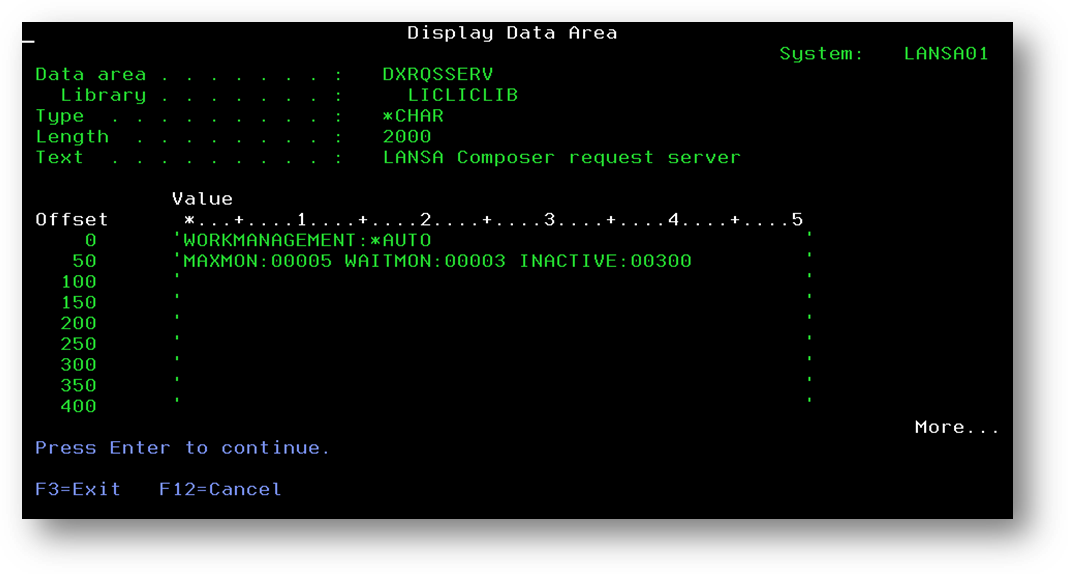 Version 7.0
Version 7.0
Settings that affect the behavior of the LANSA Composer Request Server for IBM i are contained in the data area DXRQSSERV in the library containing the LANSA Composer Request Server software. You can alter these settings in order to configure the LANSA Composer Request Server to suit your requirements and your operating environment. To alter the settings, use the CHGDTAARA (Change Data Area) command.
Note that the settings are all accessed by their position in the data area. Any text labels contained in the data area are present for ease-of-reference and are NOT used by the software to locate or identify the settings.

Work Management Mode (positions 16 - 25)
The work management mode determines whether the LANSA Composer Request Server automatically starts the request server jobs on demand and according to other settings described herein.
If the value is *AUTO, then the LANSA Composer Request Server will automatically start the request server jobs on demand.
If any other value is specified, then the LANSA Composer Request Server will NOT automatically start the request server jobs on demand. In this case it is your responsibility to start the request server jobs.
Maximum Request Server Jobs (positions 58 - 62)
When the work management mode is *AUTO, this setting determines the maximum number of request server jobs that the LANSA Composer Request Server will activate at any one time for each target LANSA system. If no request server job is "available" to process a request (within the wait time specified by the next setting), the LANSA Composer Request Server will check how many request server jobs are already active for a given target LANSA system. If the number is less than specified by this setting, the LANSA Composer Request Server will start another request server job to satisfy the request. Otherwise, no new job is started and the request is simply posted for an active request server job to process when one becomes available. In the latter case, the request may timeout or expire (according to parameters specified for the request) if an active request server job does not become available in time to process the request.
If the work management mode is not *AUTO, this setting is not used.
Wait Time for an Available Request Server Job (positions 72 - 76)
When the work management mode is *AUTO, this setting specifies the number of seconds the LANSA Composer Request Server will wait for a response from an available request server job before starting a new request server job (subject to the maximum specified by the previous setting) to satisfy the request.
If the work management mode is not *AUTO, this setting is not used.
Maximum Inactive Time for Request Server Job (positions 87 - 91)
This settings specifies the maximum number of seconds a request server job will remain active while waiting for new requests. When the specified number of seconds has elapsed since the last completed request processed by the job, the request server job will automatically end.
This setting applies irrespective of whether *AUTO is specified for the work management mode settings. However, if the work management mode is not *AUTO, you will probably need to increase the value specified in this setting to a very large value or make provision in your work management arrangements for new request server jobs to be periodically started.
Skeleton SBMJOB (Submit Job) Command (positions 769 - 1024)
When the work management mode is *AUTO, this setting specifies the command string used by the LANSA Composer Request Server to start new request server jobs. For example, as shipped, the following command string is used:
SBMJOB CMD(CALL &MONLIB/DXRQSSERV PARM('&PGMLIB'))
JOB(LCRQSSERV)
JOBQ(QUSRNOMAX)
CURLIB(*USRPRF)
INLLIBL(*SYSVAL)
USER(&PGMLIB)
If you wish to customise the way new request server jobs are started, you may alter this command string as required. If you do so, please be guided by the following:
a)Your program calls DXRQSSERV as described above.
b)Your program is a non-LANSA program and does not invoke any LANSA program.
If the work management mode is not *AUTO, this setting is not used.